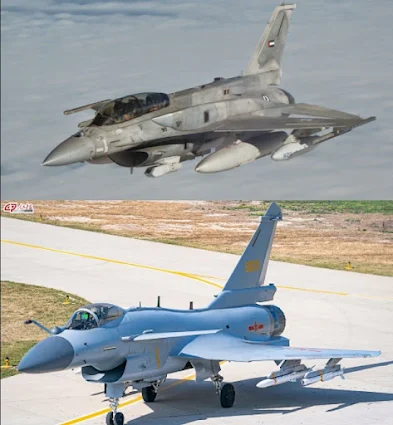 |
| the China's J-10C vs US F-16V |
Of the many advanced defense equipment owned by the US and Chinese militaries, one of them is a fighter jet. Their existence is of course very important to increase military power.
Therefore, the US and China are both developing sophisticated and extraordinary fighter jets. The US and China have successfully developed a fifth-generation stealth fighter. If the US has the F-22 Raptor, China also has the J-20 Mighty Dragon.
The F-22 and J-20 are classified into the fifth generation. In addition to having the F-22 Raptor, it turns out that the US also still has other advanced fighter jets, namely the F-16V. Likewise with China, Beijing is not only strengthened by the J-20 alone. China is also reinforced with the J-10C which is no less capable.
The US F-16 fighter jet is currently one of the most numerous and widespread fixed-wing aircraft in the world and is in use by the US Air Force. On the other hand, the J-10 is the largest fighter aircraft in the Chinese Air Force within.
Between the F-16V and J-10C which one is more formidable? To find out, see the comparison of the US F-16V vs China's J-10C, a duo of super-sophisticated fighter jets, quoted from defenseview.in:
US F-16V
The F-16 fighter is widely recognized as the most successful fourth generation aircraft in the world. The F-16 fighter has undergone many improvements and changes since it was first introduced in the late 1970s.
With no less than ten derivative models, the overall thrust of the F-110-GE-132 engine has increased by at least about 30%. The F-16V is undoubtedly a significant advancement over the outdated F-16A/B/C/D variants in terms of ability and capacity to compete on the next generation battlefield.
With the AESA radar upgrade, the F-16V will eventually be able to incorporate the AIM-120D missile with a suitable 180KM range. The F-16V fighter has the same generation of avionics and phased array radar as the F-35 fighter. Its situational awareness and flexibility are therefore anticipated to be comparable to that of the F-35 fighter.
The F-16V has a more durable fuselage and a fire control radar built by Northrop Grumman called the APG-83, which has a flight time of up to 12,000 hours. The fire control radar system and the battle information display system in the cockpit are important components of the F-16.
The F-22 and F-35 are the only 5th generation fighters with the APG-83 radar. The APG-83 significantly extends the tracking and target detection range of the F-16 jet. It has been engineered to withstand electronic interference while also being able to detect small targets more quickly. To attack enemy radar groups, the aircraft can optionally be equipped with JDAM bombs or AGM-88 HARM anti-radiation missiles.
The central display system in the cockpit is electromechanical equipment manufactured by Elbit Systems. The combat computer on the F-16 Viper has been improved. The aircraft includes new data-link technology that makes communications more accessible with advanced aircraft such as the F-22 and F-35.
China J-10C
The J-10C is an upgraded variant of the J-10B, featuring a WS-10B engine, infrared imaging seeker, and an Active Electronically Scanned Array (AESA) fire control radar. One of the most capable light fighter aircraft is the J-10C.
This has been significantly improved with the incorporation of the AESA, PL-10, PL-15 radars, and the use of stealth coatings. The design uses modern innovations made in the 1970s to offer a top-of-the-line single-engine platform. The fighter is slightly lighter than the F-16.
However, it performs better in flight, outperforming the American F110 in terms of power, speed, operational altitude and maneuverability. The fuselage is slightly lighter despite having a more powerful engine, which further enhances its maneuverability advantage. The three-dimensional thrust vector system gives the WS-10B a significant maneuverability advantage.
The J-10 also has the advantage of integrating IRST, enabling it to lock onto stealth aircraft more easily at medium and short ranges.
The J-10C benefits in weapons and better flight performance. The J-10C fighter is now considered the most advanced and powerful model of China's J-10 fighter. Beijing believes that this aircraft is one of the most powerful fighters of the current generation.
